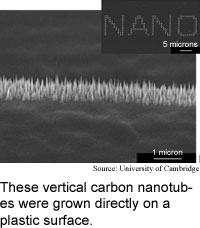
Nanotubes grown on plastic
Researchers from the University of Cambridge
in England have devised a way to grow vertical forests of carbon nanotubes
on flexible plastic.
The combination of nanoscale electronic components and a plastic
substrate could enable applications ranging from flexible electronics
like wearable computer displays to new types of fuel cells, according
to the researchers.
Carbon nanotubes are rolled-up sheets of carbon atoms. The researchers'
nanotubes ranged from 20 to 50 nanometers in diameter, which is less than
one thousandth the diameter of the human hair. Nanotubes have useful electronic
properties and can be used to form transistors, the building blocks of
computer circuits.
Other methods of combining nanotubes and plastic films involve
forming films over existing nanotubes. The researchers' technique allows
them to grow positioned, vertical nanotubes on a plastic film. Vertical
nanowires are particularly useful for making electric field emitters,
which can be used in an emerging type of flat-screen display.
Key to the researchers' approach was finding a way to grow nanotubes
that proved cool enough for the plastic to tolerate. The researchers grew
lines and dots of free-standing nanotubes onto chromium-covered polyamide
foil, and were able to cover large areas of the substrate without degrading
or bending the material.
It's not possible to tell how soon practical applications could
be available, according to the researchers. The work appeared in the December
1, 2003 issue of Applied Physics Letters.
Quantum dice debut
Pressure shapes plastic
Software repairs itself on the go
Nanoparticle dyes boost storage
Briefs:
Fiber optics goes nano
Melted fibers make nano channels
Wet biochip preserves proteins
Nanotubes grown on plastic
Hardy molecule makes memory
Atoms make quantum coprocessor

Research Watch blog
View from the High Ground Q&A
How It Works
RSS Feeds:
News
Ad links:
Buy an ad link
Ad links: Clear History
Buy an ad link
|
TRN
Newswire and Headline Feeds for Web sites
|
© Copyright Technology Research News, LLC 2000-2010. All rights reserved.